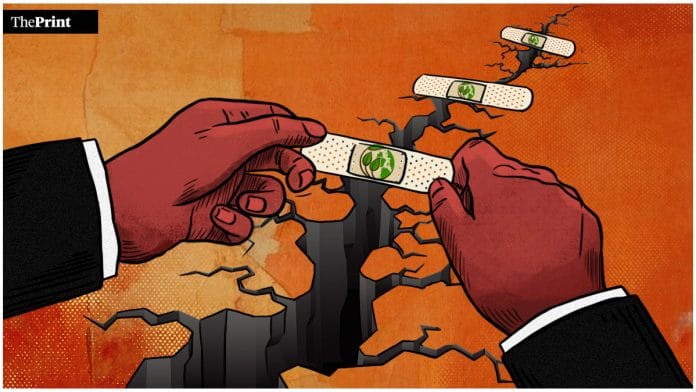The reports and commentary on soil subsidence in the pilgrimage town of Joshimath in the Garhwal Himalayas, the consequent damage to houses, and the evacuation of endangered people have rightly mentioned the neglect of past warnings.
Also mentioned in dispatches are the environmental risks involved in undertaking ambitious rail, road, hydel and other projects in a section of the Himalayas already prone to landslides and associated disasters because of large-scale deforestation.
Joshimath and the media coverage it has provoked come accompanied by a larger concern about the environment: The poor quality of the winter air in cities and towns across the northern plains; the mountains of garbage that have piled up over the years in urban agglomerations; the wasteful use of a vital but increasingly scarce resource like water; the damage already caused by climate change, like the melting of Himalayan glaciers; the extent of untreated industrial effluents; and so on.
The message percolating through is that concern about these issues is not translating into effective action to limit, let alone repair, the damage caused over several decades to the country’s air, water, land, and the natural wealth on the land (forests) as well as underneath it (minerals as also water).
That being the general dirge, it may come as a surprise to most readers that “green accounting” — which calculates sustainable growth by marrying traditional calculations of gross domestic product (GDP) with estimates of damage to the natural environment in the pursuit of GDP growth — shows a steady improvement in India’s overall green record. That was the message in a paper published last October in the Reserve Bank of India Bulletin, but it received little media attention.
In fact, there is said to be a steady closing of the gap between traditional GDP and green GDP. That implies that green GDP is growing faster than traditional GDP. In other words, India is recouping lost ground.
If you think this runs contrary to the observed reality, the paper highlights a number of government initiatives that have brought about the improvement. Among them: The ambitious push for renewable energy, reduced material consumption per unit of GDP, lower energy intensity achieved through initiatives like the large-scale adoption of LED bulbs and mandatory energy audits for energy-intensive activities, increase in material recycling, better management of solid waste through the Swachh Bharat initiative, the Namami Gange programme, and so on. The authors of the paper acknowledge that some of the improvement in recent years may be on account of better data availability.
Also read: India can pull off 6.5% growth over next 10 yrs, but not without some key policy changes
To the non-expert eye, the report in the RBI Bulletin is only a first shot at assessing green GDP. The methods used to measure it, as well as the data available — and therefore the conclusions — would improve if more minds work on the calculations, and possibly definitions as well.
While the positive message in the paper is undeniable, the key question is whether green GDP (which by definition has to do with the flow of activity) also reflects what is happening to the stock of natural capital, in terms of a balance sheet approach. Proper measurement is always the beginning of coherent corrective action. So why can’t estimates of traditional GDP be accompanied by a release of green GDP numbers? Sustainable development might then be understood and debated in its proper context.
Meanwhile, there are some choices to be made, and questions to be addressed. While construction work has been stopped for the time being in the areas near Joshimath, how does the country avoid making the future a repeat of the past with its neglect of environmental warnings in the Himalayas and elsewhere? Should paddy and sugarcane, both water-intensive crops, be grown in water-scarce areas like Haryana and parts of Maharashtra? Since agriculture is by far the biggest consumer of water, can farmers be encouraged to not deplete groundwater at the current, unsustainable rate through pricing disincentives and other initiatives like encouraging a less water-intensive way to cultivate paddy? Can the engineer-construction industry nexus be broken? And can we have stronger regulatory and associated institutions that will ensure environmental protection?
If not, the shock effect of Joshimath won’t last much more than a week.
By special arrangement with Business Standard
Also read: Food subsidies are no cure for rural distress. Why the money’s better spent on other options






